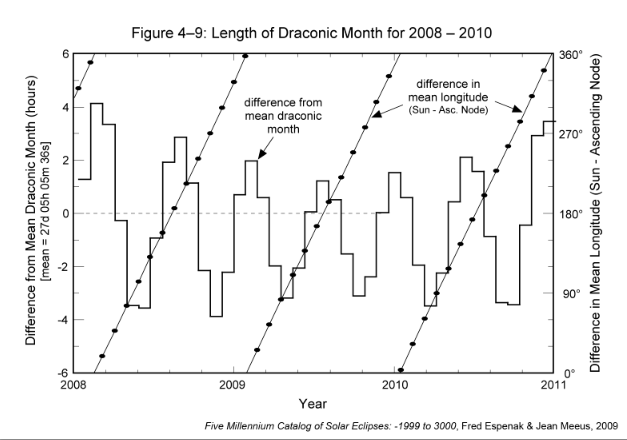The golden age in developing the theory for ocean dynamics spanned from 1775 to 1920. It was in 1775 that Pierre Simon-Laplace first developed simplified tidal equations. In historical terms this was considered the first “dynamic theory of tides” in which differential equations “describes the ocean’s real reaction to tidal forces“. The golden age perhaps culminated with A.T. Doodson’s work in cataloguing 388 tidal frequencies — and which eventually formed the basis for establishing a consensus in understanding and predicting ocean tides.
In parallel to this work, pioneering research was carried out on the non-linear differential equations known as the Mathieu and Hills equations. The initial application of the Mathieu equation was for determining the harmonics of a vibrating drum head [1]. The Hills equation was more general and found application to perturbations to periodic orbits [2]. Lord Rayleigh independently investigated what was the Mathieu equation to understand the phenomena of period doubling [3]. Eventually, the Mathieu equation found its way to modeling the dynamics of ocean basins [4], but in retrospect that work appeared flawed and was much too specific in its scope given its peculiar Ansatz in trying to cast the ocean as an elliptical drumhead. Only later in 1954 did the fundamental application of the Mathieu equation to liquid sloshing become evident [5].
So it’s interesting to speculate how far one could have taken the prediction of ENSO dynamics by applying only this early knowledge and not paying attention to any new research beyond this point, circa ~1920. Hypothetically, we could have first applied Laplace’s tidal equations and solved it along the equator, giving this canonical form, where f(t) is a forcing:

Next, consider a canonical forced wave equation operating on the thermocline that has a Mathieu component and a 1-year delayed reinforcement, and a pair of stimuli corresponding to the Draconic (nodal) and Anomalistic (perigee/apogee) tidal forces.

The 1-year delay and the biennial modulation are an interesting combination in that they essentially work in conjunction to achieve a common collective effect. For example, if the constant M is reduced in scale, the constant K needs to be increased to achieve a similar result. This is essentially the same period doubling phenomena that Lord Rayleigh originally described. So, what the Mathieu modulation does is create an inducement for a biennial recurrence within the bulk fluid properties (gravity-induced, foreshadowing the modern sloshing models [6]), while the 1 year delay is a combined memory effect and positive-feedback perturbation to reinforce that biennial property (essentially a yearly high is followed by a yearly low, and vice versa).
So for values of A=0.785, M=0.3, K=-0.15 we can achieve a strong biennial modulation that also essentially recreates the ENSO behavior for the correct combination of seasonally-reinforced Draconic and Anomalistic signals. What’s more is that the seasonal-reinforcement adopts the inflection of the biennial modulation, acting as another positive feedback to maintain the long-term biennial model (see below).

Fig 1: Mathieu modulation and seasonal impulse. The seasonal impulse aligns with the sign (concave up or concave down) of the biennial modulation to enhance the lunar forcing driving the ENSO behavior.
The strong reinforcement always occurs in November/December of each year, but reverses in sign each year to follow the Mathieu modulation. This is an Ansatz, to be sure, but it effectively recreates the long-term behavior of ENSO, shown below.

Fig 2: If we assumed only knowledge of 1880 to 1920 and used that as a training region, the extrapolated fit reproduces the rest of the ENSO behavior remarkably well. And if a longer training interval is applied, the out-of-band fit improves. This is, as always, an issue with long-period basis functions.
In the figure below we show the harmonic shape of the monthly lunar cycles. The fortnightly and 9-day harmonics are quite strong and when mixed as a multiplication, the bottom chart results. As I have asserted previously, the selectivity of the two periods is powerful. Applying anything other than precisely 27.2122 days for Draconic and 27.5545 days for Anomalistic and the fit rapidly degrades. Moreover, that also includes the phase shift of the cycles, which is necessary to align with the strongest nodal and apogee/perigee conditions.

That’s kind of a validation that someone with the brains of Laplace may have taken his original equations in this particular direction. Honestly, I’m not anywhere close to Laplace or Rayleigh in that department, but I do have access to a computer. That’s basically all it takes to reconstitute the old ideas in the new silicon age.
REFERENCES
[1] Mathieu, Émile. “Mémoire sur le mouvement vibratoire d’une membrane de forme elliptique.” Journal de mathématiques pures et appliquées 13 (1868): 137-203.
[2] Ince, Edward Lindsay. “On a general solution of Hills Equation.” Monthly Notices of the Royal Astronomical Society 75 (1915): 436-448.
[3] Rayleigh, Lord. “XXXIII. On maintained vibrations.” The London, Edinburgh, and Dublin Philosophical Magazine and Journal of Science 15.94 (1883): 229-235.
[4] S. Goldstein, “Tidal Motion in Rotating Elliptic Basins of Constant Depth.,” Geophysical Journal International, vol. 2, no. s4, pp. 213–232, 1929.
[5] Benjamin, T. Brooke, and F. Ursell. “The stability of the plane free surface of a liquid in vertical periodic motion.” Proceedings of the Royal Society of London A: Mathematical, Physical and Engineering Sciences. Vol. 225. No. 1163. The Royal Society, 1954.
[6] J. B. Frandsen, “Sloshing motions in excited tanks,” Journal of Computational Physics, vol. 196, no. 1, pp. 53–87, 2004.






 By comparison, the model fit to ENSO shows the rapid oscillations near many of the same regions. In particular look at intervals indicated by diamonds 1 and 6 below, as well as the interval just before 1950.
By comparison, the model fit to ENSO shows the rapid oscillations near many of the same regions. In particular look at intervals indicated by diamonds 1 and 6 below, as well as the interval just before 1950.






